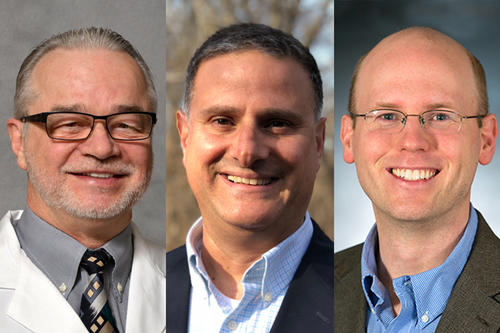
From Parkinson’s disease to depression, many serious health problems facing society today have something in common—they stem from the function (or dysfunction) of our brains.
Researchers at the University of Minnesota are on the leading edge of new and improved treatments for many common and debilitating brain disorders. Through the use of neuromodulation—a collection of similar techniques that all involve adjusting the activity of certain neural circuits—these scientists are working to more effectively treat symptoms in a lasting way with fewer side effects.
Interdisciplinary U of M research into neuromodulation is led by the state-funded MnDRIVE Brain Conditions program and the National Institutes of Health-funded Udall Center of Excellence for Parkinson’s Disease Research.
Jerrold Vitek, Ph.D., MD
“A tremendous number of people with Parkinson’s disease are not getting the therapy that could significantly benefit them and improve not only their lives, but the lives of their families. Market penetration of deep brain stimulation (DBS) for Parkinson's in the US is only at 10 percent of those who would be good candidates for the treatment. Worldwide, it is estimated at 5 percent.
“Development of new technology, understanding how we can get consistent and precise placement of DBS leads in these deep brain structures and to fully understand all the variables that contribute to the degree of benefit patients can receive are all important areas that we are working on at the U of M.
“The ability to do DBS while patients are asleep would likely alleviate some of the potential anxiety of undergoing the procedure and we are currently working on developing the imaging that would allow us to do this with the same accuracy as we currently use when patients are awake. Better imaging, which we are developing here, is critical, but also how we define the target in the operating room and how we can determine the precise location of where the leads are within the implanted target postoperatively are critical pieces to continuing to improve DBS.
“There are various approaches to DBS used by different centers. I personally think it is important for us to develop standards that are determined to give the best outcomes. This is a challenge, but I think a necessary step to ensure we are providing each patient the most benefit.”
Jerrold Vitek, Ph.D., MD, is a professor and head of the Department of Neurology in the Medical School and director of the Udall Center of Excellence for Parkinson’s Disease Research.
Contact information:
Jerrold Vitek
[email protected]
612-624-1903
Noam Harel, Ph.D.
“At the University’s Center for Magnetic Resonance Research (CMRR) we are using the most advanced MRI scanners to develop new imaging capabilities that allow us to visualize the human brain in higher resolution and with greater details than ever before. These advanced imaging and 3D visualization capabilities open the door to new diagnostics and treatment approaches for personalized medicine.
“Deep brain stimulation (DBS) is a surgical procedure of precision. Implanting a DBS electrode in the right location in the brain is critical for achieving maximum benefit for the patient; the consequences of not hitting the right brain target can result in significant adverse effects and negative outcomes. The tools that we are developing allow the surgical team to literally ‘see’ inside the patient’s brain, making the surgery quicker, safer and more precise.”
Noam Harel, Ph.D., is professor in both the Department of Radiology and the Department of Neurosurgery in the Medical School, and leader of the Imaging Core in the Udall Center of Excellence for Parkinson’s Disease Research.
Contact information:
[email protected]
612-625-8399
Matthew Johnson, Ph.D.
“The efficacy of DBS therapy also depends on finding the most effective stimulation setting for each patient. Some symptoms resolve in seconds with DBS therapy whereas others may take minutes to hours to fully resolve. This limits the number of stimulation settings that one can evaluate within the context of a single clinical exam visit.
“With the recent advances in directional DBS lead technologies, which position electrodes both along and around the DBS lead implant, there are exciting opportunities to more selectively target pathways in the brain that we know enhance DBS therapy. However, directional DBS lead technology with its higher number of electrode sites, greatly increases the complexity of tuning DBS therapy.
“At the University of Minnesota, we have developed a series of computational methods and algorithms that leverage patient-specific brain imaging to predict which stimulation settings will likely provide optimal therapy for a given patient. Together, these algorithms show promise in making clinical visits more efficient as well as in helping tune DBS settings to deliver more effective therapy for each patient.”
Matthew Johnson, Ph.D., is an associate professor in the Department of Biomedical Engineering in the College of Science and Engineering.
Contact information:
[email protected]
612-626-6492
About University of Minnesota experts
University of Minnesota experts can provide commentary, insights and opinions on various news topics. See selected experts on UMN’s Experts Guide or inquire about additional experts via email at [email protected].
Media note
The University of Minnesota Twin Cities is equipped with a VideoLink ReadyCam® studio for live or taped HD television interviews with our experts. To arrange an interview, contact the University News Service at (612) 624-5551 or [email protected].
- Categories:
- Health




